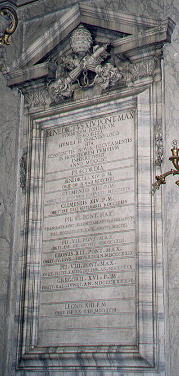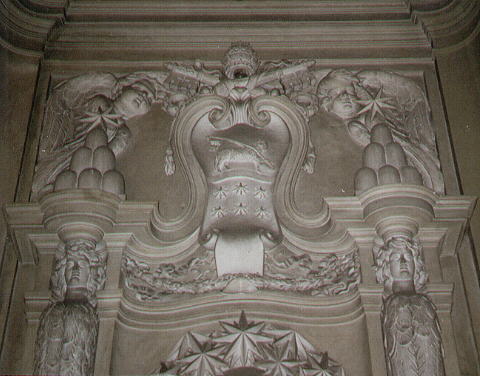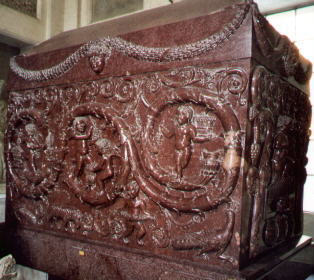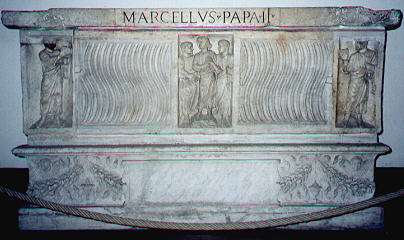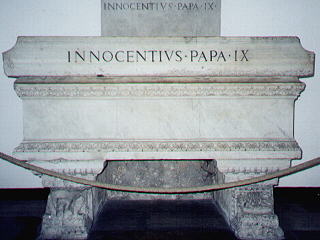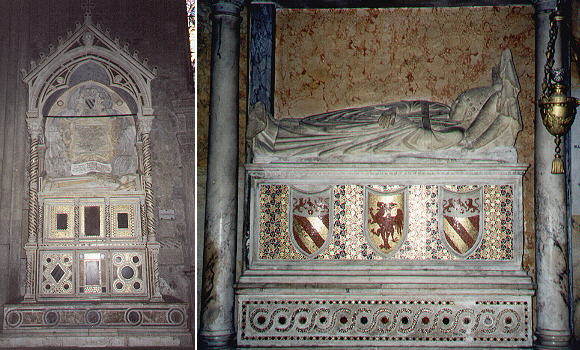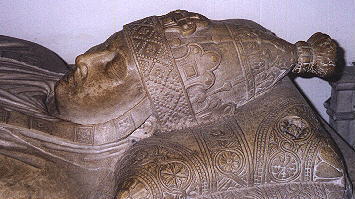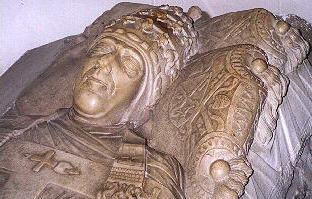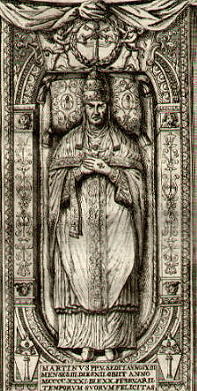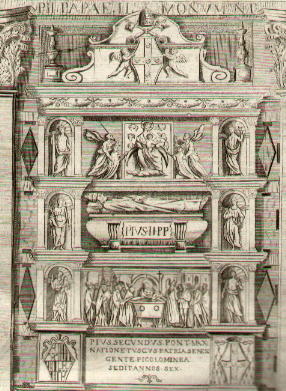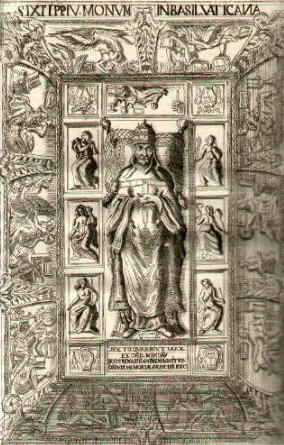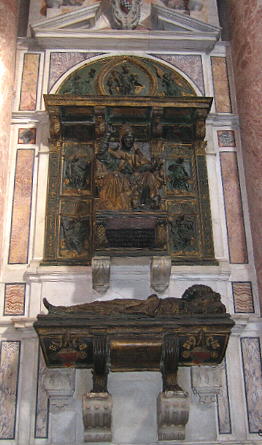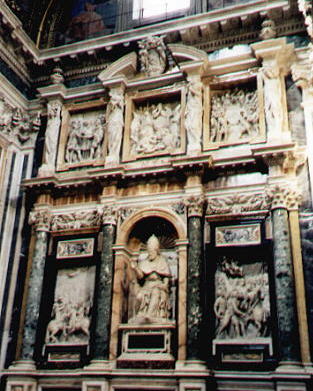  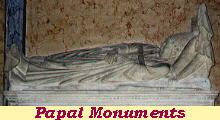 Part one - Medieval and Renaissance Monuments
Introduction Part one - Medieval and Renaissance Monuments
Introduction
These pages briefly deal with the evolution of the monuments to the popes from the XIIIth century to the XIXth century. In most cases the monuments are very large
and it is difficult to take an acceptable picture without professional equipment and special arrangements: for this reason the images accompanying the text very often show details of the monuments.
In several cases the monuments are not the actual location of the bodies of the popes, which either are lost or are kept in a different site. The hearts and other inner parts of the body (praecordia) are kept in the
church of SS. Vincenzo e Anastasio. The burial places of some medieval popes
were discovered during the restoration of S. Giovanni in Laterano, S. Maria Maggiore and other churches and this led to building some
Renaisssance or Baroque monuments to them. An example is the Monument to Sergius IV (1009-12) designed by Francesco Borromini in S. Giovanni in Laterano and decorated with the heraldic symbols (six mountains and a star) of Alexander VII (1655-67).
These monuments are not discussed in these pages. Some monuments were designed if not actually completed during the lifetime of the pope (Bonifatius VIII, Julius II, Sixtus V, Paulus V, Urbanus VIII, Clemens IX are among the popes
who took care of their own monuments), other monuments were commissioned by the Cardinal Nepote (i. e. a nephew of the pope who assisted him in the government of the State of the Church) soon after the death of the pope. In some cases however
the monument was designed many years after the death of the pope so while there is a broad correlation between the death of the pope and the execution of his monument, there are some
remarkable exceptions and for this reason in page three the monuments are also listed chronologically. Many monuments to the popes are in S. Pietro, but not all of them: some
monuments were moved from the old basilica when it was pulled down at the end of the XVIth century to other churches in Rome, other monuments were located in other churches because the popes had a special affection for them. In conclusion there are more than ten
churches having monuments to the popes.
Sarcophagi
During the first millennium A. D. the role of the pope was almost entirely confined to religious matters and although he had a significant
role in the political life of Rome
and took decisions such as building walls and castles there is no evidence of monuments to the popes. The first pope who deemed necessary
to emphasize his role by means of a monument was Anastasius IV (1153-54) who wanted to be buried in a large IVth century porphyry Roman sarcophagus, found in the
Ruins of Sepolcro di S. Elena and moved by him to S. Giovanni in Laterano (now in the Vatican Museums).
His example was followed by other popes. When the monuments to the popes developed a more complex structure,
the use of a Roman sarcophagus was not totally abandoned, but it was restricted to the popes who had been in office only for a matter of days and whose relatives did not have
the financial means to erect a monument. During the Renaissance many Roman sarcophagi were recovered and this led to an ample choice of sarcophagi with a suitable (non pagan) decoration.
Gisants
Many gisant monuments were erected in S. Pietro Vecchio and were moved to other churches when the old basilica was pulled down (the Monument to Honorius IV shown in the image here above was moved to S. Maria in Aracoeli in 1545).
Other monuments were completely lost or only the statue of the pope was saved. The statue of Bonifatius VIII (1294-1303) is of particular interest because the pope himself
decided to be portrayed as a (relatively) young man and with the papal insignia (in particular the elaborated crown). The statue of Nicholas V (1447-55) is slightly turned to the left to improve its visibility.
Antonio del Pollaiolo Some deviations from the gisant pattern were experimented in the XVth century in part because of the great development in the use of
bronze which had occurred in Florence with Lorenzo Ghiberti. The Monument to Martinus V (1417-31) by the Florentine sculptor Simone di Giovanni Ghini in S. Giovanni in Laterano is made of a large
bronze plate which renovated the tradition of the medieval marble plates used in the churches to indicate where the rich were buried. The Monuments to Pius II (1458-64) and to his nephew Pius III (1503), previously in S. Pietro Vecchio and moved to S. Andrea della Valle in 1614, both show
the statue of the pope framed in a complex decoration which includes other statues and reliefs.
The large and low bronze Monument to Sixtus V (1471-84) by Antonio del Pollaiolo was given a unique structure as it was designed for being located at the center of a chapel. The reliefs around the statue of the pope show the Seven Virtues (*) (inner circle) and ten allegories of Art and Science (outer circle). The Monument to Sixtus IV brought to Antonio del Pollaiolo the commission for the Monument to Innocentius VIII (1484-92), which became a turning point in the history of the monuments to the popes as it portrayed the pope both lying down in the traditional gisant posture and seated on his throne in the act of blessing.
XVIth Century Developments
In the XVIth century the monuments to the popes abandoned the gisant posture and showed the
pope seated on his throne in the act of blessing. A change was introduced in the Monuments to Sixtus V (1585-90) and Paulus V (1605-21) who preferred to be portrayed in the act of praying on their
knees (they both were alive when the monuments were completed and this explains why they preferred a humble posture).
The statue of the pope was usually located in a niche at the center of a complex structure resembling a triumphal arch and decorated with other statues and reliefs.
The four Monuments to the popes in Cappella Sistina (Pius V and Sixtus V) and in Cappella Paolina (Clemens VIII and Paulus V) in Santa Maria Maggiore show the final (and very expensive)
development of the Renaissance pattern of monument.
(*) 3 theological virtues (Faith, Charity and Hope) and 4 cardinal virtues (Prudence, Justice, Strength and Temperance). Move to Part two - Baroque and Neoclassical Monuments Move to Part three - Lists of the Monuments Note: the icon of Papal Monuments shows a detail of the Monument to Honorius IV in S. Maria in Aracoeli. The image used as a background for this page shows a detail of the Monument to Leo XI by Alessandro Algardi in S. Pietro. Other pages dealing with Baroque sculpture: Statues in the act of praying Representation of Death in Baroque sculptures Monuments showing the dead in a medallion Baroque Angels Three chapels by Gian Lorenzo Bernini Three busts by Alessandro Algardi Statues Close to Heaven Embittered Andrew (the statues in St. Peter's octagon) Laughing Masks See also my List of Baroque Architects and my Directory of Baroque Sculpture. 
Go to my Home
Page on Baroque Rome or to my Home Page on Rome
in the footsteps of an XVIIIth century traveller.
|
All images © 1999 - 2003 by Roberto Piperno. Write to romapip@quipo.it
